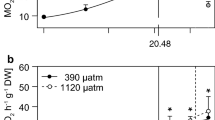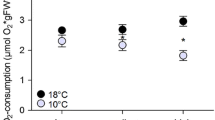Abstract
The accumulation of CO2 in the atmosphere and resulting ocean acidification represent a threat to marine ecosystems. While acid–base regulatory capacity is well developed in marine fish, allowing compensation of extra-cellular pH during short-term hypercapnia, the possible energetic costs of such regulation during long-term exposure remain to be established. In this study, juvenile European sea bass (Dicentrarchus labrax) were exposed from 2 days post-hatching to three different ocean acidification scenarios: control (present condition, \( P_{{{\text{CO}}_{2} }} \) = 520 µatm, pH 7.9), moderate acidification (\( P_{{{\text{CO}}_{2} }} \) = 950 µatm, pH 7.7), and high acidification (\( P_{{{\text{CO}}_{2} }} \) = 1490 µatm, pH 7.5). After 1.5 years of exposure, fish aerobic metabolic capacities, as well as elements of their oxygen extraction and transport chain, were measured. Compared to control, \( P_{{{\text{CO}}_{2} }} \) treatments did not affect fish standard metabolic rate (SMR). However, the most severe acidification condition was associated with a significantly elevated maximum metabolic rate (MMR).This was supported by heavier gill system and higher blood haemoglobin concentration. A reduction of maximum cardiac frequency (fHmax) during incremental warming of anaesthetized fish was also observed in both acidification scenarios. On the other hand, the critical oxygen level (O2crit), the minimum oxygen level required to sustain SMR, did not differ among groups. The increased MMR, associated with maintained SMR, suggests that acid–base compensatory processes, although not increasing maintenance costs, may affect components of bass homeostasis, resulting in new internal physico-chemical conditions. The possibility that these alterations influence metabolic pathways and physiological functions involved in fish aptitude to maximally transport oxygen is discussed.





Similar content being viewed by others
References
Aminot A, Kerouel R, Coverly S (2009) Nutrients in seawater using segmented flow analysis practical guidelines for the analysis of seawater. CRC Press, Boca Raton, pp 143–178
Anttila K, Casselman MT, Schulte PM, Farrell AP (2013) Optimum temperature in juvenile salmonids: connecting subcellular indicators to tissue function and whole-organism thermal optimum. Physiol Biochem Zool 86:245–256. https://doi.org/10.1086/669265
Bresolin de Souza K, Jutfelt F, Kling P, Förlin L, Sturve J (2014) Effects if increased CO2 on fish gill and plasma proteome. PLoS One 9:e102901
Burggren W, McMahon B, Powers D (1991) Respiratory functions of blood. In: Prosser CL (ed) Environmental and metabolic animal physiology, New York, pp 437–508
Caldeira K, Wickett ME (2005) Ocean model predictions of chemistry changes from carbon dioxide emissions to the atmosphere and ocean. J Geophys Res 110:C09S04. https://doi.org/10.1029/2004jc002671
Casselman MT, Anttila K, Farrell AP (2012) Using maximum heart rate as a rapid screening tool to determine optimum temperature for aerobic scope in Pacific salmon Oncorhynchus spp. J Fish Biol 80:358–377. https://doi.org/10.1111/j.1095-8649.2011.03182.x
Chabot D, Steffensen JF, Farrell AP (2016) The determination of standard metabolic rate in fishes. J Fish Biol 88:81–121
Chapman L, Albert J, Galis F (2008) Developmental plasticity, genetic differentiation, and hypoxia-induced trade-offs in an African cichlid fish. Open Evol J 2:75–88
Claireaux G, Chabot D (2016) Responses by fishes to environmental hypoxia: integration through Fry’s concept of aerobic metabolic scope. J Fish Biol 88:232–251
Claireaux G, Lefrançois C (2007) Linking environmental variability and fish performance: integration through the concept of scope for activity. Philos Trans R Soc B Biol Sci 362:2031–2041
Couturier CS, Stecyk JAW, Rummer JL, Munday PL, Nilsson GE (2013) Species-specific effects of near-future CO2 on the respiratory performance of two tropical prey and their predator. Comp Biochem Physiol 166:482–489
Crespel A, Zambonino-Infante JL, Mazurais D, Koumoundouros G, Fragkoulis S, Quazuguel P, Huelvan C, Madec L, Servili A, Claireaux G (2017) The development of contemporary European sea bass larvae (Dicentrarchus labrax) is not affected by projected ocean acidification scenarios. Mar Biol. https://doi.org/10.1007/s00227-017-3178-x
Deigweiher K, Koschnick N, Pörtner HO, Lucassen M (2008) Acclimation of ion regulatory capacities in gills of marine fish under environmental hypercapnia. Am J Physiol Regul Integrat Comp Physiol 295:R1660–R1670
Deigweiher K, Hirse T, Bock C, Lucassen M, Pörtner HO (2010) Hypercapnia induced shifts in gill energy budgets of Antarctic notothenioids. J Comp Physiol B Biochem Syst Environ Physiol 180:347–359
Dickson AG, Sabine CL, Christian JR (2007) Guide to best practices for ocean CO2 measurements. PICES Spec Publ 3:191
Enzor LA, Zippay ML, Place SP (2013) High latitude in a high CO2 world: synergistic effects of elevated temperature and carbon dioxide on the metabolic rates of Antarctic notothenioids. Comp Biochem Physiol A Mol Integrat Physiol 164:154–161
Ern R, Johansen JL, Rummer JL, Esbaugh AJ (2017) Effects of hypoxia and ocean acidification on the upper thermal niche boundaries of coral reef fishes. Biol Lett. https://doi.org/10.1098/rsbl.2017.0135
Esbaugh AJ (2018) Physiological implications of ocean acidification for marine fish: emerging patterns and new insights. J Comp Physiol B Biochem Syst Environ Physiol 188:1–13. https://doi.org/10.1007/s00360-017-1105-6
Esbaugh AJ, Heuer R, Grosell M (2012) Impacts of ocean acidification on respiratory gas exchange and acid–base balance in a marine teleost, Opsanus beta. J Comp Physiol B Biochem Syst Environ Physiol 182:921–934. https://doi.org/10.1007/s00360-012-0668-5
Esbaugh AJ, Ern R, Nordi WM, Johnson AS (2016) Respiratory plasticity is insufficient to alleviate blood acid–base disturbances after acclimation to ocean acidification in the estuarine red drum, Sciaenops ocellatus. J Comp Physiol B Biochem Syst Environ Physiol 186:97–109. https://doi.org/10.1007/s00360-015-0940-6
Evans DH, Piermarini PM, Choe KP (2005) The multifunctional fish gill: dominant site of gas exchange, osmoregulation, acid–base regulation, and excretion of nitrogenous waste. Physiol Rev 85:97–177
Farrell AP, Eliason EJ, Clark TD, Steinhausen MF (2014) Oxygen removal from water versus arterial oxygen delivery: calibrating the Fick equation in Pacific salmon. J Comp Physiol B Biochem Syst Environ Physiol 184:855–864. https://doi.org/10.1007/s00360-014-0839-7
Fry FEJ (1971) The effect of environmental factors on the physiology of fish. In: Hoar WS, Randall DJ (eds) Fish physiology. Academic Press, New York, pp 1–98
Gräns A, Jutfelt F, Sandblom E, Jönsson E, Wiklander K, Seth H, Olsson C, Dupont S, Ortega-Martinez O, Einarsdottir I et al (2014) Aerobic scope fails to explain the detrimental effects on growth resulting from warming and elevated CO2 in Atlantic halibut. J Exp Biol 217:711–717
Hannan KD, Rummer JL (2018) Aquatic acidification: a mechanism underpinning maintained oxygen transport and performance in fish expecting elevated carbon dioxide conditions. J Exp Biol 221:jeb154559. https://doi.org/10.1242/jeb.154559
Heuer RM, Grosell M (2014) Physiological impacts of elevated carbon dioxide and ocean acidification on fish. Am J Physiol Regul Integrat Comp Physiol 307:R1061–R1084. https://doi.org/10.1152/ajpregu.00064.2014
Intergovernmental Panel on Climate Change I (2014) Climate change 2014: synthesis Report. In: CoreWritingTeam, Pachauri RK, Meyer LA (eds) Contribution of working groups I, II and III to the fifth assessment report of the intergovernmental panel on climate change. IPCC, Geneva, p 151
Jourdan-Pineau H, Dupont-Prinet A, Claireaux G, McKenzie D (2010) An investigation of metabolic prioritization in the European Sea Bass, Dicentrarchus labrax. Physiol Biochem Zool 83:68–77
Killen SS, Norin T, Halsey LG (2017) Do methods and species lifestyle affect measures of maximum metabolic rate in fishes? J Fish Biol 90:1037–1046
Kroeker KJ, Kordas RL, Crim RN, Singh GG (2010) Meta-analysis reveals negative yet variable effects of ocean acidification on marine organisms. Ecol Lett 13:1419–1434. https://doi.org/10.1111/j.1461-0248.2010.01518.x
Kroeker KJ, Kordas RL, Crim RN, Hendriks IE, Ramajo L, Singh GS, Duarte CM, Gattuso JP (2013) Impacts of ocean acidification on marine organisms: quantifying sensitivities and interaction with warming. Glob Change Biol 19:1884–1896
Lefevre S (2016) Are global warming and ocean acidification conspiring against marine ectotherms? A meta-analysis of the respiratory effects of elevated temperature, high CO2 and their interaction. Conserv Physiol 4:cow009. https://doi.org/10.1093/conphys/cow009
Leo E, Kunz KL, Schmidt M, Storch D, Portner HO, Mark FC (2017) Mitochondrial acclimation potential to ocean acidification and warming of Polar cod (Boreogadus saida) and Atlantic cod (Gadus morhua). Front Zool 14:21. https://doi.org/10.1186/s12983-017-0205-1
Lewis E, Wallace DWR (1998) Program developed for CO2 system calculations., ORNL/CDIAC-105. Carbon Dioxide Information Analysis Center, Oak Ridge National Laboratory, U. S. Department of Energy, Oak Ridge
Lüthi D, Le Floch M, Bereiter B, Blunier T, Barnola JM, Siegenthaler U, Raynaud D, Jouzel J, Fischer H, Kawamura K, Stocker TF (2008) High-resolution carbon dioxide concentration record 650,000-800,000 years before present. Nature 453:379–382. https://doi.org/10.1038/nature06949
McKenzie D, Piccolella M, Valle AZD, Taylor EW, Bolis CL, Steffensen JF (2003) Tolerance of chronic hypercapnia by the European ell Anguilla anguilla. J Exp Biol 206:1717–1726
Mehrbach C, Culberson CH, Hawley JE, Pytkowicx RM (1973) Measurement of the apparent dissociation constants of carbonic acid in seawater at atmospheric pressure. Limnol Oceanogr 18:897–907
Melzner F, Göbel S, Langenbuch M, Gutowska MA, Portner HO, Lucassen M (2009) Swimming performance in Atlantic cod (Gadus morhua) following long-term (4–12 months) acclimation to elevated seawater P(CO2). Aquat Toxicol 92:30–37
Michaelidis B, Spring A, Portner HO (2007) Effects of long-term acclimation to environmental hypercapnia on extracellular acid–base status and metabolic capacity in Mediterranean fish Sparus aurata. Mar Biol 150:1417–1429. https://doi.org/10.1007/s00227-006-0436-8
Nilsson GE, Renshaw GM (2004) Hypoxic survival strategies in two fishes: extreme anoxia tolerance in the North European Crucian carp and natural hypxic preconditionning in a coral-reef shark. J Exp Biol 207:3131–3139
Omlin T, Weber JM (2010) Hypoxia stimulates lactate disposal in rainbow trout. J Exp Biol 213:3802–3809. https://doi.org/10.1242/jeb.048512
Phuong LM, Huong DTT, Malte H, Nyengaard JR, Bayley M (2018) Ontogeny and morphometrics of the gills and swim bladder of air-breathing striped catfish Pangasianodon hypophthalmus. J Exp Biol. https://doi.org/10.1242/jeb.168658
Pörtner HO, Farrell AP (2008) Physiology and climate change. Science 322:690–692
Pörtner HO, Langenbuch M, Reipschlager A (2004) Biological impact of elevated ocean CO2 concentrations: lessons from animal physiology and earth history. J Oceanogr 60:705–718. https://doi.org/10.1007/s10872-004-5763-0
Rogers NJ, Urbina MA, Reardon EE, McKenzie D, Wilson R (2016) A new analysis of hypoxia tolerance in fishes using a database of critical oxygen level (P crit). Conserv Physiol 4:cow012. https://doi.org/10.1093/conphys/cow012
Rummer JL, Stecyk JAW, Couturier CS, Watson SA, Nilsson G, Munday PL (2013) Elevated CO2 enhances aerobic scope of a coral reef fish. Conserv Physiol 1:cot023
Schmidt-Nielsen K (1997) Animal physiology: adaptation and environment. University Press, Cambridge
Sollid J, Nilsson GE (2006) Plasticity of respiratory structures—adaptive remodeling of fish gills induced by ambient oxygen and temperature. Respir Physiol Neurobiol 154:241–251. https://doi.org/10.1016/j.resp.2006.02.006
Vanderplancke G, Claireaux G, Quazuguel P, Madec L, Ferraresso S, Sévère A, Zambonino-Infante JL, Mazurais D (2015) Hypoxic episode during larval period has long-term effects on European sea bass juveniles (Dicentrarchus labrax). Mar Biol 162:367–376. https://doi.org/10.1007/s00227-014-2601-9
Witeska M (2013) Erythrocytes in teleost fishes: a review. Zool Ecol 23:275–281. https://doi.org/10.1080/21658005.2013.846963
Yeager DP, Ultsh GR (1989) Physiological regulation and conformation: a BASIC program for the determination of critical points. Physiol Zool 62:888–907
Zhang Y, Claireaux G, Takle H, Jorgensen SM, Farrell AP (2018) A three-phase excess post-exercise oxygen consumption in Atlantic salmon Salmo salar and its response to exercise training. J Fish Biol 92:4. https://doi.org/10.1111/jfb.13593
Acknowledgements
The authors would like to thank N. Lamande, F. Salvetat, C. Le Bihan, and F. Caradec for their help with the water chemistry sampling and data analysis. This work was supported by Region Bretagne (SAD-PERPHYMO), co-funded by a Grant from the French government under the program “Investissements d’Avenir”, by the Society for Experimental Biology (SEB), and by The Company of Biologists (COB).
Author information
Authors and Affiliations
Contributions
Conceptualization: AC, KA, GC. Methodology: AC, KA, GC. Software: DC. Formal analysis: PL, AC, KA. Resources: PQ, NLB, ZLZI, GC. Writing—original draft: PL, AC. Writing—review and editing: AC, KA, GC, PL, JLZI, DC. Supervision: AC, JLZI, GC. Project administration: JLZI, GC. Funding acquisition: JLZI, GC
Corresponding author
Ethics declarations
Conflict of interest
The authors declare no competing or financial interests.
Ethical approval
All applicable international, national, and/or institutional guidelines for the care and use of animals were followed. Project code: APAFIS 4341.03, #201620211505680.V3.
Additional information
Responsible Editor: A. E. Todgham.
Publisher's Note
Springer Nature remains neutral with regard to jurisdictional claims in published maps and institutional affiliations.
Reviewed by A. Frommel and an undisclosed expert.
Rights and permissions
About this article
Cite this article
Crespel, A., Anttila, K., Lelièvre, P. et al. Long-term effects of ocean acidification upon energetics and oxygen transport in the European sea bass (Dicentrarchus labrax, Linnaeus). Mar Biol 166, 116 (2019). https://doi.org/10.1007/s00227-019-3562-9
Received:
Accepted:
Published:
DOI: https://doi.org/10.1007/s00227-019-3562-9




